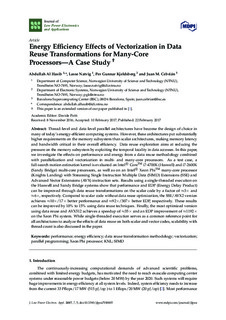| dc.contributor.author | Al Hasib, Abdullah | |
| dc.contributor.author | Natvig, Lasse | |
| dc.contributor.author | Kjeldsberg, Per Gunnar | |
| dc.contributor.author | Cebrian, Juan Manuel | |
| dc.date.accessioned | 2018-08-22T11:09:58Z | |
| dc.date.available | 2018-08-22T11:09:58Z | |
| dc.date.created | 2018-01-09T14:49:03Z | |
| dc.date.issued | 2017 | |
| dc.identifier.issn | 2079-9268 | |
| dc.identifier.uri | http://hdl.handle.net/11250/2558826 | |
| dc.description.abstract | Thread-level and data-level parallel architectures have become the design of choice in many of today’s energy-efficient computing systems. However, these architectures put substantially higher requirements on the memory subsystem than scalar architectures, making memory latency and bandwidth critical in their overall efficiency. Data reuse exploration aims at reducing the pressure on the memory subsystem by exploiting the temporal locality in data accesses. In this paper, we investigate the effects on performance and energy from a data reuse methodology combined with parallelization and vectorization in multi- and many-core processors. As a test case, a full-search motion estimation kernel is evaluated on Intel® CoreTM i7-4700K (Haswell) and i7-2600K (Sandy Bridge) multi-core processors, as well as on an Intel® Xeon PhiTM many-core processor (Knights Landing) with Streaming Single Instruction Multiple Data (SIMD) Extensions (SSE) and Advanced Vector Extensions (AVX) instruction sets. Results using a single-threaded execution on the Haswell and Sandy Bridge systems show that performance and EDP (Energy Delay Product) can be improved through data reuse transformations on the scalar code by a factor of ≈3× and ≈6×, respectively. Compared to scalar code without data reuse optimization, the SSE/AVX2 version achieves ≈10×/17× better performance and ≈92×/307× better EDP, respectively. These results can be improved by 10% to 15% using data reuse techniques. Finally, the most optimized version using data reuse and AVX512 achieves a speedup of ≈35× and an EDP improvement of ≈1192× on the Xeon Phi system. While single-threaded execution serves as a common reference point for all architectures to analyze the effects of data reuse on both scalar and vector codes, scalability with thread count is also discussed in the paper. | nb_NO |
| dc.language.iso | eng | nb_NO |
| dc.publisher | MDPI | nb_NO |
| dc.rights | Navngivelse 4.0 Internasjonal | * |
| dc.rights.uri | http://creativecommons.org/licenses/by/4.0/deed.no | * |
| dc.title | Energy Efficiency Effects of Vectorization in Data Reuse Transformations for Many-Core Processors—A Case Study | nb_NO |
| dc.type | Journal article | nb_NO |
| dc.type | Peer reviewed | nb_NO |
| dc.description.version | publishedVersion | nb_NO |
| dc.source.volume | 7 | nb_NO |
| dc.source.journal | Journal of Low Power Electronics and Applications | nb_NO |
| dc.source.issue | 1 | nb_NO |
| dc.identifier.doi | 10.3390/jlpea7010005 | |
| dc.identifier.cristin | 1538999 | |
| dc.description.localcode | (C) 2017 by the authors; licensee MDPI, Basel, Switzerland. This article is an open access article distributed under the terms and conditions of the Creative Commons Attribution (CC BY) license (http://creativecommons.org/licenses/by/4.0/). | nb_NO |
| cristin.unitcode | 194,63,10,0 | |
| cristin.unitcode | 194,63,35,0 | |
| cristin.unitname | Institutt for datateknologi og informatikk | |
| cristin.unitname | Institutt for elektroniske systemer | |
| cristin.ispublished | true | |
| cristin.fulltext | original | |
| cristin.qualitycode | 1 | |

